Sustainability Assessment and Source Apportionment of Soil Heavy Metals in a Mineral Aggregation Area of Datian County, South China
Abstract
:1. Introduction
2. Materials and Methods
2.1. Study Area
2.2. Sampling Point Arrangement and Sample Collection
2.3. Soil Sample Processing and Analysis
2.4. Research Methods
2.4.1. Geoaccumulation Index
2.4.2. Ecological Risk Assessment
2.4.3. PMF Model
2.5. Data Processing and Analysis
3. Results and Discussion
3.1. Descriptive Statistics of the Soil Heavy Metal Content
3.2. Distribution of Heavy Metal Pollution
3.3. Pollution and Risk Assessment
3.3.1. Geoaccumulation Index Values of the Heavy Metals
3.3.2. Ecological Risk Assessment of the Heavy Metals
3.4. Analysis of Soil Heavy Metal Pollution Sources
3.4.1. Correlation Analysis
3.4.2. Preliminary Analysis of Pollution Sources Based on PCA
3.4.3. Source Apportionment Based on PMF
4. Conclusions
Author Contributions
Funding
Informed Consent Statement
Data Availability Statement
Acknowledgments
Conflicts of Interest
References
- Wang, Y.; Duan, X.; Wang, L. Spatial distribution and source analysis of heavy metals in soils influenced by industrial enterprise distribution: Case study in Jiangsu Province. Sci. Total Environ. 2020, 710, 134953. [Google Scholar] [CrossRef] [PubMed]
- Liao, S.; Jin, G.; Khan, M.A.; Zhu, Y.; Duan, L.; Luo, W.; Jia, J.; Zhong, B.; Ma, J.; Ye, Z.; et al. The quantitative source apportionment of heavy metals in peri-urban agricultural soils with UNMIX and input fluxes analysis. Environ. Technol. Innov. 2021, 21, 101232. [Google Scholar] [CrossRef]
- González-Morales, M.; Fernández-Pozo, L.; Rodríguez-González, M.Á. Threats of metal mining on ecosystem services. Conservation proposals. Environ. Res. 2022, 214, 114036. [Google Scholar] [CrossRef] [PubMed]
- Deng, Y.; Jiang, L.; Xu, L.; Hao, X.; Zhang, S.; Xu, M.; Zhu, P.; Fu, S.; Liang, Y.; Yin, H.; et al. Spatial distribution and risk assessment of heavy metals in contaminated paddy fields—A case study in Xiangtan City, southern China. Ecotoxicol. Environ. Saf. 2019, 171, 281–289. [Google Scholar] [CrossRef] [PubMed]
- Upadhyay, V.; Kumari, A.; Kumar, S. From soil to health hazards: Heavy metals contamination in northern India and health risk assessment. Chemosphere 2024, 354, 141697. [Google Scholar] [CrossRef] [PubMed]
- Yang, J.; Sun, Y.; Wang, Z.; Gong, J.; Gao, J.; Tang, S.; Ma, S.; Duan, Z. Heavy metal pollution in agricultural soils of a typical volcanic area: Risk assessment and source appointment. Chemosphere 2022, 304, 135340. [Google Scholar] [CrossRef] [PubMed]
- Cheng, S. Heavy metal pollution in China: Origin, pattern and control. Environ. Sci. Pollut. Res. Int. 2003, 10, 192–198. [Google Scholar] [CrossRef] [PubMed]
- Pan, H.; Lu, X.; Lei, K. A comprehensive analysis of heavy metals in urban road dust of Xi’an, China: Contamination, source apportionment and spatial distribution. Sci. Total Environ. 2017, 609, 1361–1369. [Google Scholar] [CrossRef]
- FAO; UNEP. Global Food Systems and Environmental Impact; FAO: Rome, Italy, 2021. [Google Scholar]
- Huang, G.; Wang, X.; Chen, D.; Wang, Y.; Zhu, S.; Zhang, T.; Liao, L.; Tian, Z.; Wei, N. A hybrid data-driven framework for diagnosing contributing factors for soil heavy metal contaminations using machine learning and spatial clustering analysis. J. Hazard. Mater. 2022, 437, 129324. [Google Scholar] [CrossRef]
- Li, Y.; Kuang, H.; Hu, C.; Ge, G. Source Apportionment of Heavy Metal Pollution in Agricultural Soils around the Poyang Lake Region Using UNMIX Model. Sustainability 2021, 13, 5272. [Google Scholar] [CrossRef]
- Martinková, E.; Kochergina, Y.V.E.; Šebek, O.; Seibert, R.; Chrastný, V.; Novák, M.; Štěpánová, M.; Čuřík, J.; Pacherová, P.; Přechová, E.; et al. Winter-time pollution in Central European cities shifts the 208Pb/207Pb isotope ratio of atmospheric PM2.5 to higher values: Implications for lead source apportionment. Atmos. Environ. 2023, 310, 119941. [Google Scholar] [CrossRef]
- Dragović, S.; Smičiklas, I.; Jović, M.; Čupić, A.; Dragović, R.; Gajić, B.; Onjia, A. Spatial distribution and source apportionment of DTPA-extractable metals in soils surrounding the largest Serbian steel production plant. Heliyon 2023, 9, e16307. [Google Scholar] [CrossRef] [PubMed]
- Xing, W.; Zheng, Y.; Scheckel, K.G.; Luo, Y.; Li, L. Spatial distribution of smelter emission heavy metals on farmland soil. Environ. Monit. Assess. 2019, 191, 115. [Google Scholar] [CrossRef] [PubMed]
- Xiao, J.; Chen, W.; Wang, L.; Zhang, X.; Wen, Y.; Bostick, B.C.; Wen, Y.; He, X.; Zhang, L.; Zhuo, X.-J.; et al. New strategy for exploring the accumulation of heavy metals in soils derived from different parent materials in the karst region of southwestern China. Geoderma 2022, 417, 115806. [Google Scholar] [CrossRef]
- Jin, Y.; O’Connor, D.; Ok, Y.S.; Tsang, D.C.W.; Liu, A.; Hou, D. Assessment of sources of heavy metals in soil and dust at children’s playgrounds in Beijing using GIS and multivariate statistical analysis. Environ. Int. 2019, 124, 320–328. [Google Scholar] [CrossRef]
- Forghani Tehrani, G.; Rubinos, D.A.; Kelm, U.; Ghadimi, S. Environmental and human health risks of potentially harmful elements in mining-impacted soils: A case study of the Angouran Zn–Pb Mine, Iran. J. Environ. Manag. 2023, 334, 117470. [Google Scholar] [CrossRef]
- Fei, X.F.; Lou, Z.H.; Xiao, R.; Ren, Z.Q.; Lv, X.N. Contamination assessment and source apportionment of heavy metals in agricultural soil through the synthesis of PMF and GeogDetector models. Sci. Total Environ. 2020, 747, 141293. [Google Scholar] [CrossRef]
- Haghighizadeh, A.; Rajabi, O.; Nezarat, A.; Hajyani, Z.; Haghmohammadi, M.; Hedayatikhah, S.; Asl, S.D.; Aghababai Beni, A. Comprehensive analysis of heavy metal soil contamination in mining Environments: Impacts, monitoring Techniques, and remediation strategies. Arab. J. Chem. 2024, 17, 105777. [Google Scholar] [CrossRef]
- Ma, W.; Tai, L.; Qiao, Z.; Zhong, L.; Wang, Z.; Fu, K.; Chen, G. Contamination source apportionment and health risk assessment of heavy metals in soil around municipal solid waste incinerator: A case study in North China. Sci. Total Environ. 2018, 631–632, 348–357. [Google Scholar] [CrossRef]
- Li, X.; Zhang, R.; Tripathee, L.; Yu, F.; Guo, J.; Yang, W.; Guo, J.; Kang, S.; Cao, J. Characteristics, sources, and health risk assessment of atmospheric particulate mercury in Guanzhong Basin. Environ. Pollut. 2024, 342, 123071. [Google Scholar] [CrossRef]
- Shan, B.; Wang, G.; Cao, F.; Wu, D.; Liang, W.; Sun, R. Mercury emission from underground coal fires in the mining goaf of the Wuda Coalfield, China. Ecotoxicol. Environ. Saf. 2019, 182, 109409. [Google Scholar] [CrossRef] [PubMed]
- Schneider, L.; Rose, N.L.; Myllyvirta, L.; Haberle, S.; Lintern, A.; Yuan, J.; Sinclair, D.; Holley, C.; Zawadzki, A.; Sun, R. Mercury atmospheric emission, deposition and isotopic fingerprinting from major coal-fired power plants in Australia: Insights from palaeo-environmental analysis from sediment cores. Environ. Pollut. 2021, 287, 117596. [Google Scholar] [CrossRef] [PubMed]
- Shao, F.; Li, K.; Ouyang, D.; Zhou, J.; Luo, Y.; Zhang, H. Sources apportionments of heavy metal(loid)s in the farmland soils close to industrial parks: Integrated application of positive matrix factorization (PMF) and cadmium isotopic fractionation. Sci. Total Environ. 2024, 924, 171598. [Google Scholar] [CrossRef] [PubMed]
- Zhou, H.; Yue, X.; Chen, Y.; Liu, Y. Source-specific probabilistic contamination risk and health risk assessment of soil heavy metals in a typical ancient mining area. Sci. Total Environ. 2024, 906, 167772. [Google Scholar] [CrossRef]
- Liu, Z.; Fei, Y.; Shi, H.; Mo, L.; Qi, J. Prediction of high-risk areas of soil heavy metal pollution with multiple factors on a large scale in industrial agglomeration areas. Sci. Total Environ. 2022, 808, 151874. [Google Scholar] [CrossRef] [PubMed]
- Chen, C.; Fujian Provincial Local Chronicles Compilation Committee. Dadian County Annals; Xiamen University Press: Xiamen, China, 2009. [Google Scholar]
- HJ/T 166-2004; The Technical Specification for Soil Environmental Monitoring. Ministry of Ecology and Environment of the People’s Republic of China: Beijing, China, 2004.
- Muller, G. Index of Geoaccumulation in Sediments of the Rhine River. GeoJournal 1969, 2, 109–118. [Google Scholar]
- Zhu, Y.; An, Y.; Li, X.; Cheng, L.; Lv, S. Geochemical characteristics and health risks of heavy metals in agricultural soils and crops from a coal mining area in Anhui province, China. Environ. Res. 2024, 241, 117670. [Google Scholar] [CrossRef]
- Hakanson, L. An ecological risk index for aquatic pollution control. A sedimentological approach. Water Res. 1980, 14, 975–1001. [Google Scholar] [CrossRef]
- Yan, F.; Li, N.; Wang, J.; Wu, H. Ecological footprint model of heavy metal pollution in water environment based on the potential ecological risk index. J. Environ. Manag. 2023, 344, 118708. [Google Scholar] [CrossRef]
- Ahamad, M.I.; Song, J.X.; Sun, H.T.; Wang, X.X.; Mehmood, M.S.; Sajid, M.; Su, P.; Khan, A.J. Contamination Level, Ecological Risk, and Source Identification of Heavy Metals in the Hyporheic Zone of the Weihe River, China. Int. J. Environ. Res. Public Health 2020, 17, 1070. [Google Scholar] [CrossRef]
- Pan, L.B.; Wang, Y.; Ma, J.; Hu, Y.; Su, B.Y.; Fang, G.L.; Wang, L.; Xiang, B. A review of heavy metal pollution levels and health risk assessment of urban soils in Chinese cities. Environ. Sci. Pollut. Res. 2018, 25, 1055–1069. [Google Scholar] [CrossRef] [PubMed]
- GB 15618-2018; Soil Environmental Quality Risk Control Standard for Soil Contamination of Agricultural Land. Ministry of Ecology and Environment of the People’s Republic of China: Beijing, China, 2018.
- Wu, J.; Li, J.; Teng, Y.; Chen, H.; Wang, Y. A partition computing-based positive matrix factorization (PC-PMF) approach for the source apportionment of agricultural soil heavy metal contents and associated health risks. J. Hazard. Mater. 2020, 388, 121766. [Google Scholar] [CrossRef] [PubMed]
- Paatero, P.; Tapper, U. Positive matrix factorization: A non-negative factor model with optimal utilization of error estimates of data values. Environmetrics 1994, 5, 111–126. [Google Scholar] [CrossRef]
- Chen, J.; Wei, F.; Zheng, C.; Wu, Y.; Adriano, D.C. Background concentrations of elements in soils of China. Water Air Soil Pollut. 1991, 57–58, 699–712. [Google Scholar] [CrossRef]
- Whelen, T.; Siqueira, P. Coefficient of variation for use in crop area classification across multiple climates. Int. J. Appl. Earth Obs. Geoinf. 2018, 67, 114–122. [Google Scholar] [CrossRef]
- Islam, M.S.; Hossain, M.B.; Matin, A.; Sarker, M.S.I. Assessment of heavy metal pollution, distribution and source apportionment in the sediment from Feni River estuary, Bangladesh. Chemosphere 2018, 202, 25–32. [Google Scholar] [CrossRef] [PubMed]
- Marrugo-Negrete, J.; Pinedo-Hernández, J.; Díez, S. Assessment of heavy metal pollution, spatial distribution and origin in agricultural soils along the Sinú River Basin, Colombia. Environ. Res. 2017, 154, 380–388. [Google Scholar] [CrossRef] [PubMed]
- Liang, J.; Liu, Z.; Tian, Y.; Shi, H.; Fei, Y.; Qi, J.; Mo, L. Research on health risk assessment of heavy metals in soil based on multi-factor source apportionment: A case study in Guangdong Province, China. Sci. Total Environ. 2023, 858, 159991. [Google Scholar] [CrossRef]
- Liu, B.; Zhao, S.; Qiu, T.; Cui, Q.; Yang, Y.; Li, L.; Chen, J.; Huang, M.; Zhan, A.; Fang, L. Interaction of microplastics with heavy metals in soil: Mechanisms, influencing factors and biological effects. Sci. Total Environ. 2024, 918, 170281. [Google Scholar] [CrossRef]
- Peng, Y.; Yu, G.I. Assessment of heavy metal pollution on agricultural land in Chengdu city under different anthropogenic pressures based on APCS-MLR modelling. Ecol. Indic. 2024, 165, 112183. [Google Scholar] [CrossRef]
- Jahandari, A.; Abbasnejad, B. Environmental pollution status and health risk assessment of selective heavy metal(oid)s in Iran’s agricultural soils: A review. J. Geochem. Explor. 2024, 256, 107330. [Google Scholar] [CrossRef]
- Shi, X.; Liu, S.; Song, L.; Wu, C.; Yang, B.; Lu, H.; Wang, X.; Zakari, S. Contamination and source-specific risk analysis of soil heavy metals in a typical coal industrial city, central China. Sci. Total Environ. 2022, 836, 155694. [Google Scholar] [CrossRef] [PubMed]
- Long, Z.; Zhu, H.; Bing, H.; Tian, X.; Wang, Z.; Wang, X.; Wu, Y. Contamination, sources and health risk of heavy metals in soil and dust from different functional areas in an industrial city of Panzhihua City, Southwest China. J. Hazard. Mater. 2021, 420, 126638. [Google Scholar] [CrossRef] [PubMed]
- O’Keefe, J.M.K.; Henke, K.R.; Hower, J.C.; Engle, M.A.; Stracher, G.B.; Stucker, J.D.; Drew, J.W.; Staggs, W.D.; Murray, T.M.; Hammond, M.L.; et al. CO2, CO, and Hg emissions from the Truman Shepherd and Ruth Mullins coal fires, eastern Kentucky, USA. Sci. Total Environ. 2010, 408, 1628–1633. [Google Scholar] [CrossRef] [PubMed]
- Brusseau, M.L.; Matthias, A.D.; Comrie, A.C.; Musil, S.A. Chapter 17—Atmospheric Pollution. In Environmental and Pollution Science, 3rd ed.; Brusseau, M.L., Pepper, I.L., Gerba, C.P., Eds.; Academic Press: Cambridge, MA, USA, 2019; pp. 293–309. [Google Scholar]
- Zhu, H.; Wang, H.; Jing, S.; Wang, Y.; Cheng, T.; Tao, S.; Lou, S.; Qiao, L.; Li, L.; Chen, J. Characteristics and sources of atmospheric volatile organic compounds (VOCs) along the mid-lower Yangtze River in China. Atmos. Environ. 2018, 190, 232–240. [Google Scholar] [CrossRef]
- Zhou, X.Y.; Wang, X.R. Impact of industrial activities on heavy metal contamination in soils in three major urban agglomerations of China. J. Clean. Prod. 2019, 230, 1–10. [Google Scholar] [CrossRef]
- Xiao, L.; Guan, D.; Chen, Y.; Dai, J.; Ding, W.; Peart, M.R.; Zhang, C. Distribution and availability of heavy metals in soils near electroplating factories. Environ. Sci. Pollut. Res. 2019, 26, 22596–22610. [Google Scholar] [CrossRef]
- Huang, J.; Wu, Y.; Sun, J.; Li, X.; Fan, Z. Health risk assessment of heavy metal(loid)s in park soils of the largest megacity in China by using Monte Carlo simulation coupled with Positive matrix factorization model. J. Hazard. Mater. 2021, 415, 125629. [Google Scholar] [CrossRef] [PubMed]
- Wang, F.; Li, W.; Wang, H.; Hu, Y.; Cheng, H. The leaching behavior of heavy metal from contaminated mining soil: The effect of rainfall conditions and the impact on surrounding agricultural lands. Sci. Total Environ. 2024, 914, 169877. [Google Scholar] [CrossRef]
- Viard, B.; Pihan, F.; Promeyrat, S.; Pihan, J.-C. Integrated assessment of heavy metal (Pb, Zn, Cd) highway pollution: Bioaccumulation in soil, Graminaceae and land snails. Chemosphere 2004, 55, 1349–1359. [Google Scholar] [CrossRef]
- Cooke, C.A.; Martínez-Cortizas, A.; Bindler, R.; Sexauer Gustin, M. Environmental archives of atmospheric Hg deposition—A review. Sci. Total Environ. 2020, 709, 134800. [Google Scholar] [CrossRef]
- Ao, M.; Qiu, G.; Zhang, C.; Xu, X.; Zhao, L.; Feng, X.; Qin, S.; Meng, B. Atmospheric deposition of antimony in a typical mercury-antimony mining area, Shaanxi Province, Southwest China. Environ. Pollut. 2019, 245, 173–182. [Google Scholar] [CrossRef]
- Zhen, H.; Jia, L.; Huang, C.; Qiao, Y.; Li, J.; Li, H.; Chen, Q.; Wan, Y. Long-term effects of intensive application of manure on heavy metal pollution risk in protected-field vegetable production. Environ. Pollut. 2020, 263, 114552. [Google Scholar] [CrossRef]
- Huang, Q.; Yu, Y.; Wan, Y.; Wang, Q.; Luo, Z.; Qiao, Y.; Su, D.; Li, H. Effects of continuous fertilization on bioavailability and fractionation of cadmium in soil and its uptake by rice (Oryza sativa L.). J. Environ. Manag. 2018, 215, 13–21. [Google Scholar] [CrossRef]
- Dai, X.; Liang, J.; Shi, H.; Yan, T.; He, Z.; Li, L.; Hu, H. Health risk assessment of heavy metals based on source analysis and Monte Carlo in the downstream basin of the Zishui. Environ. Res. 2024, 245, 117975. [Google Scholar] [CrossRef]
- Peng, S.; Zhang, H.; Song, D.; Chen, H.; Lin, X.; Wang, Y.; Ji, L. Distribution of antibiotic, heavy metals and antibiotic resistance genes in livestock and poultry feces from different scale of farms in Ningxia, China. J. Hazard. Mater. 2022, 440, 129719. [Google Scholar] [CrossRef] [PubMed]
- Lu, X.; Lu, P.; Chen, J.; Zhang, H.; Fu, J. Effect of passivator on Cu form transformation in pig manure aerobic composting and application in soil. Environ. Sci. Pollut. Res. 2015, 22, 14727–14737. [Google Scholar] [CrossRef] [PubMed]
- Varol, M.; Gündüz, K.; Sünbül, M.R. Pollution status, potential sources and health risk assessment of arsenic and trace metals in agricultural soils: A case study in Malatya province, Turkey. Environ. Res. 2021, 202, 111806. [Google Scholar] [CrossRef] [PubMed]
- Zhang, Y.; Song, B.; Zhou, Z. Pollution assessment and source apportionment of heavy metals in soil from lead—Zinc mining areas of south China. J. Environ. Chem. Eng. 2023, 11, 109320. [Google Scholar] [CrossRef]
- Hu, Y.; He, K.; Sun, Z.; Chen, G.; Cheng, H. Quantitative source apportionment of heavy metal(loid)s in the agricultural soils of an industrializing region and associated model uncertainty. J. Hazard. Mater. 2020, 391, 122244. [Google Scholar] [CrossRef]
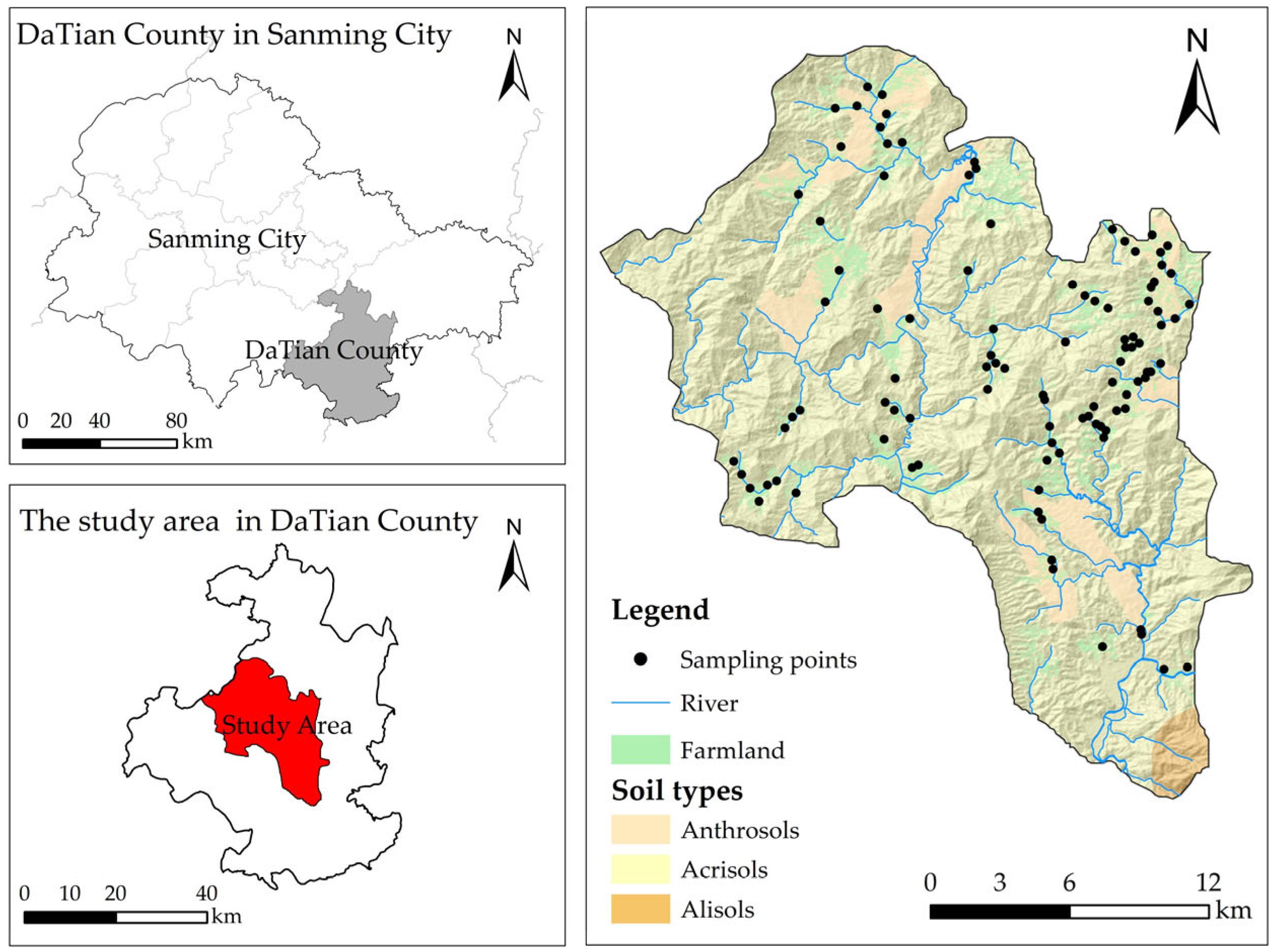

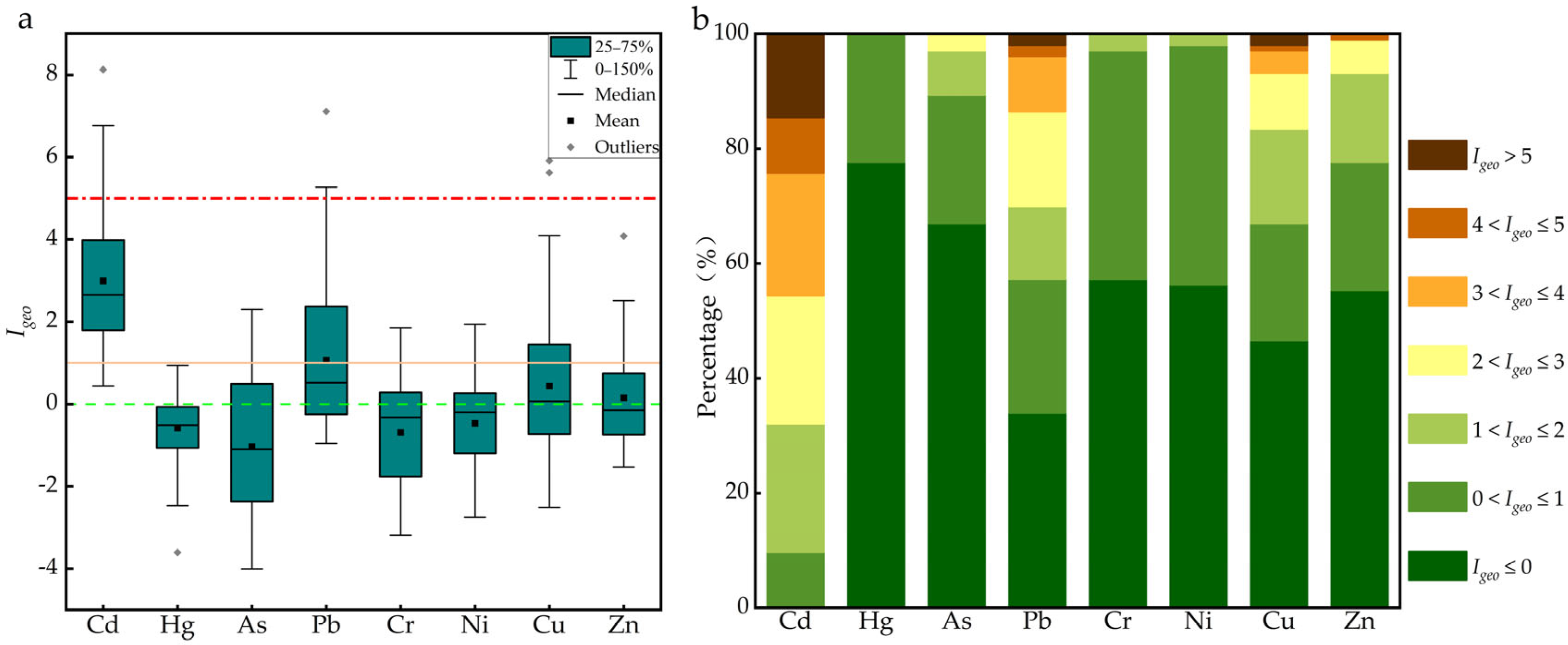
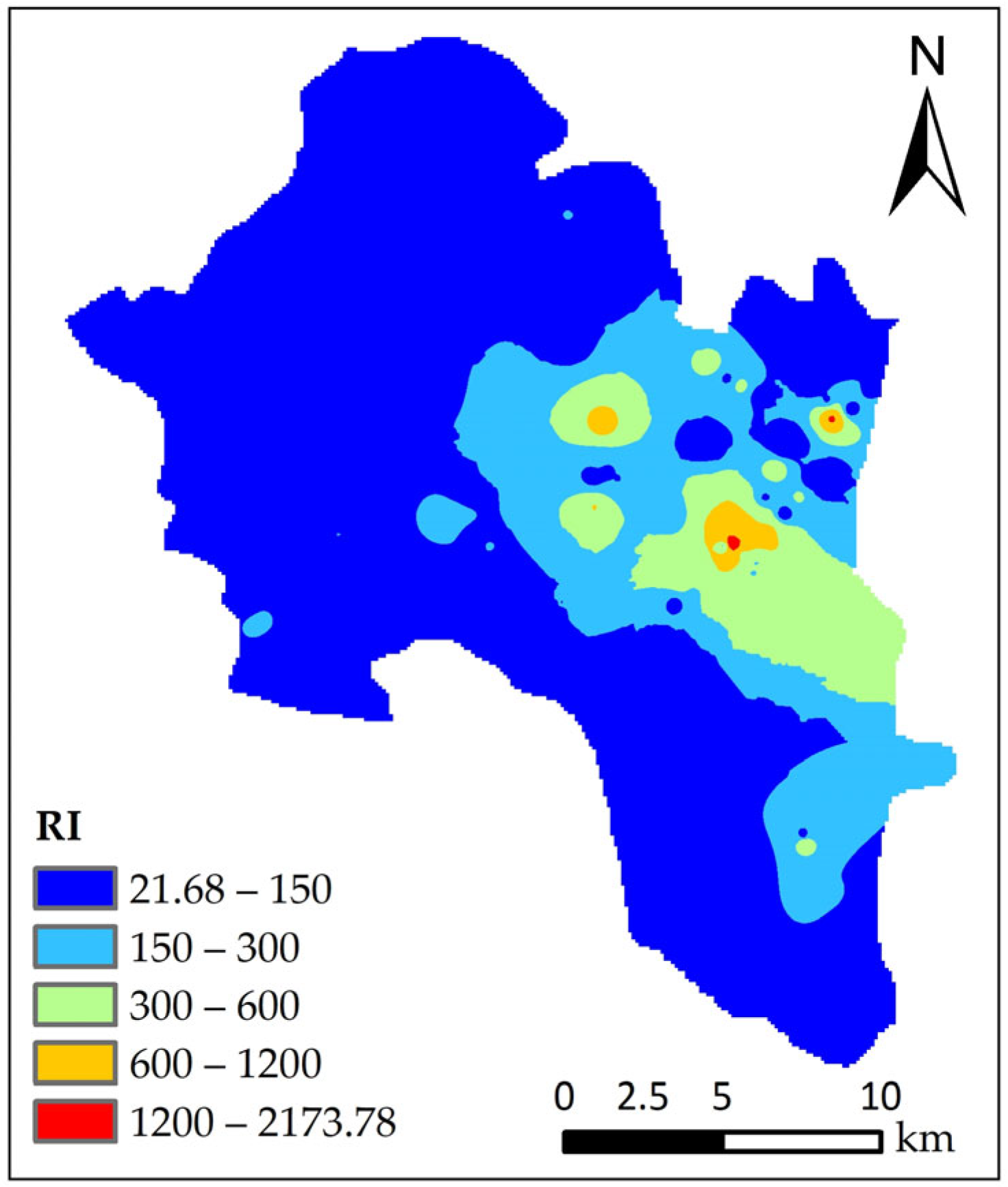
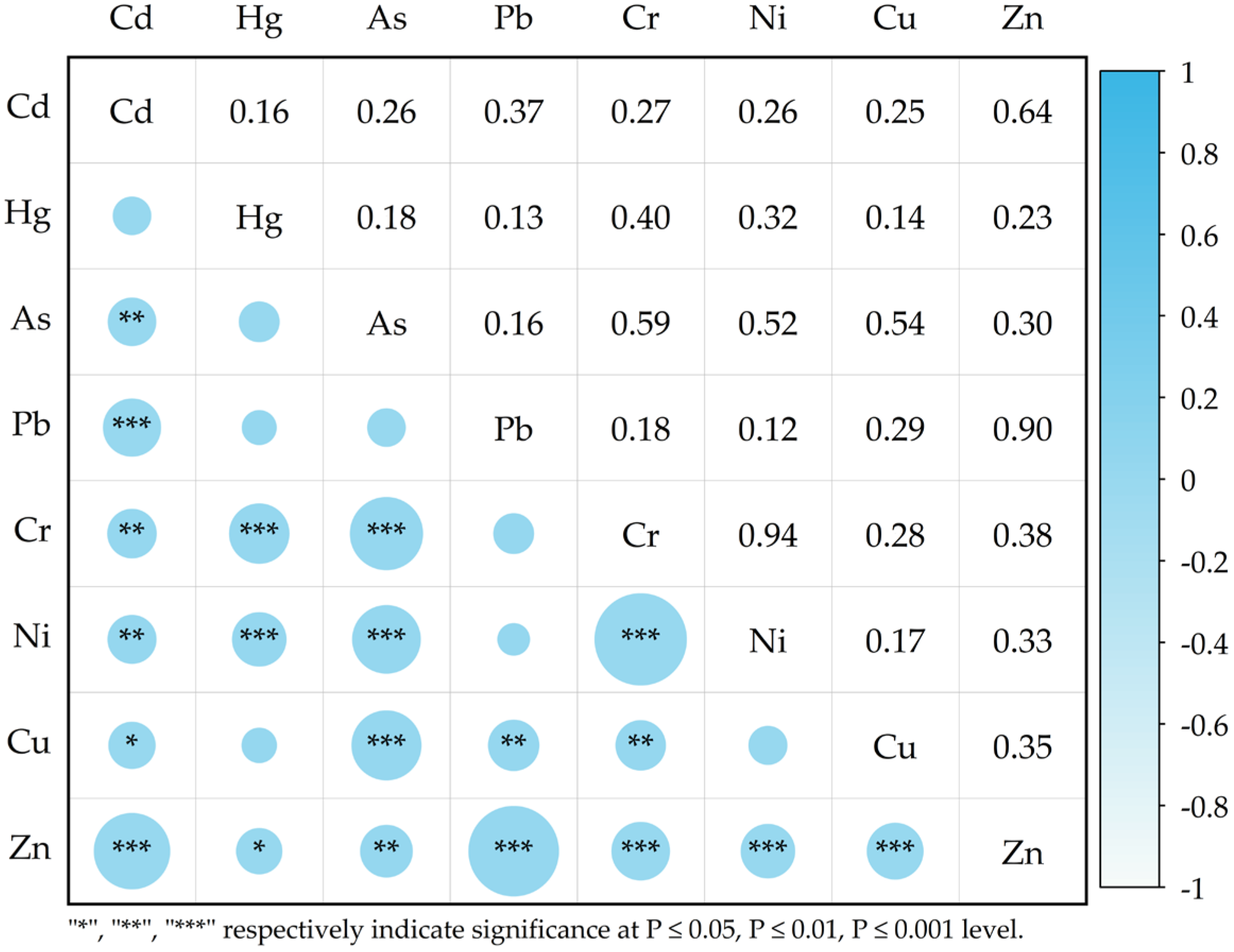
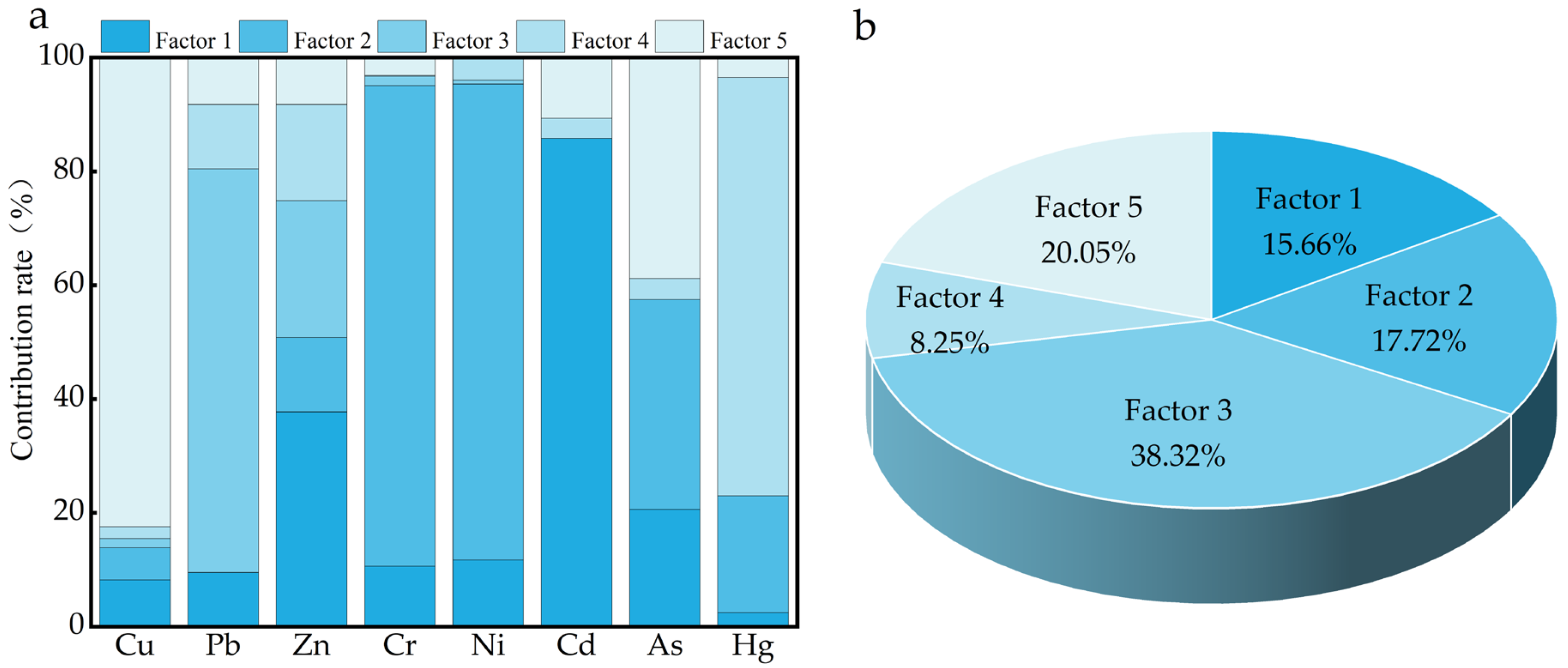

| Geoaccumulation Index Method [31] | Potential Ecological Risk Index Method [32] | ||||||
|---|---|---|---|---|---|---|---|
| Classification | Igeo | Degree of Contamination | Risk Level | Er | Degree of Contamination (Single Factor) | RI | Degree of Contamination |
| 1 | ≤0 | uncontaminated | 1 | <40 | Slight | <150 | Slight |
| 2 | 0–1 | uncontaminated to moderately contaminated | 2 | 40–80 | Moderate | 150–300 | Moderate |
| 3 | 1–2 | moderately contaminated | 3 | 80–160 | Strong | 300–600 | Strong |
| 4 | 2–3 | moderately to heavily contaminated | 4 | 160–320 | Very Strong | 600–1200 | Very Strong |
| 5 | 3–4 | heavily contaminated | 5 | ≥320 | Extremely Strong | ≥1200 | Extremely Strong |
| 6 | 4–5 | heavily to extremely contaminated | - a | - | - | - | - |
| 7 | >5 | extremely contaminated | - | - | - | - | - |
| Indicators | Cd | Hg | As | Pb | Cr | Ni | Cu | Zn | pH |
|---|---|---|---|---|---|---|---|---|---|
| Min | 0.11 | 0.01 | 0.54 | 27 | 6.8 | 3 | 5.7 | 43.1 | 4.16 |
| Max | 22.7 | 0.233 | 42.8 | 7233 | 223 | 77.8 | 1960 | 2097 | 7.75 |
| Median | 0.51 | 0.085 | 4.04 | 75.1 | 49.4 | 17.6 | 34 | 112 | 5.37 |
| Mean | 1.40 | 0.09 | 7.53 | 265.17 | 51.67 | 18.14 | 101.51 | 198.37 | 5.42 |
| SD | 2.67 | 0.04 | 8.24 | 750.35 | 37.27 | 11.81 | 252.58 | 244.94 | 0.59 |
| CV | 1.91 | 0.44 | 1.09 | 2.83 | 0.72 | 0.65 | 2.49 | 1.23 | 0.11 |
| Screening a | 0.30 | 0.50 | 30.00 | 70.00 | 150.00 | 60.00 | 50.00 | 200.00 | - b |
| Screening exceedance rate | 70.87 | 0 | 3.88 | 52.43 | 1.94 | 0.97 | 38.83 | 25.24 | - |
| Background c | 0.05 | 0.08 | 5.78 | 34.90 | 41.30 | 13.50 | 21.60 | 82.70 | - |
| Background exceedance rate | 100.00 | 53.40 | 43.69 | 91.26 | 55.34 | 58.25 | 71.84 | 69.90 | - |
| Category | Median | Mean | Max | Number of Points with Moderate or Higher Risk | |
|---|---|---|---|---|---|
| Er ≥ 40 | RI ≥ 150 | ||||
| Cd | 51.00 | 139.83 | 2270.00 | 62 | - a |
| Hg | 6.80 | 7.25 | 18.64 | 0 | - |
| As | 1.35 | 2.51 | 14.27 | 0 | - |
| Pb | 5.36 | 18.94 | 516.64 | 9 | - |
| Cr | 0.66 | 0.69 | 2.97 | 0 | - |
| Ni | 1.47 | 1.51 | 6.48 | 0 | - |
| Cu | 3.40 | 10.15 | 196.00 | 3 | - |
| Zn | 0.56 | 0.99 | 10.49 | 0 | - |
| RI | 75.03 | 181.87 | 2326.42 | - | 30 |
| Element Indicators | Factor Loadings of Variables on Each Principal Component | ||||
|---|---|---|---|---|---|
| PC1 | PC2 | PC3 | PC4 | PC5 | |
| Cd | 0.13 | 0.28 | 0.12 | 0.94 | 0.06 |
| Hg | 0.21 | 0.08 | 0.06 | 0.06 | 0.97 |
| As | 0.55 | 0.04 | 0.70 | 0.11 | −0.02 |
| Pb | 0.03 | 0.98 | 0.11 | 0.08 | 0.04 |
| Cr | 0.93 | 0.13 | 0.18 | 0.07 | 0.20 |
| Ni | 0.96 | 0.08 | 0.06 | 0.11 | 0.12 |
| Cu | 0.03 | 0.20 | 0.92 | 0.08 | 0.08 |
| Zn | 0.21 | 0.87 | 0.16 | 0.38 | 0.09 |
| Eigenvalues | 3.50 | 1.63 | 1.02 | 0.79 | 0.63 |
| Variance contribution Rate (%) | 43.78 | 20.43 | 12.73 | 9.81 | 7.92 |
| Cumulative variance contribution rate (%) | 43.78 | 64.21 | 76.94 | 86.74 | 94.67 |
| Factor | Cd | Hg | As | Pb | Cr | Ni | Cu | Zn |
|---|---|---|---|---|---|---|---|---|
| 1 | 85.79 | 2.47 | 20.59 | 9.50 | 10.59 | 11.69 | 8.20 | 37.73 |
| 2 | 0.00 | 20.50 | 36.89 | 0.00 | 84.48 | 83.63 | 5.64 | 13.08 |
| 3 | 0.00 | 0.00 | 0.00 | 70.94 | 1.65 | 0.69 | 1.64 | 24.04 |
| 4 | 3.54 | 73.50 | 3.70 | 11.34 | 0.17 | 3.99 | 2.06 | 16.89 |
| 5 | 10.67 | 3.53 | 38.82 | 8.22 | 3.11 | 0.00 | 82.46 | 8.26 |
Disclaimer/Publisher’s Note: The statements, opinions and data contained in all publications are solely those of the individual author(s) and contributor(s) and not of MDPI and/or the editor(s). MDPI and/or the editor(s) disclaim responsibility for any injury to people or property resulting from any ideas, methods, instructions or products referred to in the content. |
© 2024 by the authors. Licensee MDPI, Basel, Switzerland. This article is an open access article distributed under the terms and conditions of the Creative Commons Attribution (CC BY) license (https://creativecommons.org/licenses/by/4.0/).
Share and Cite
Wang, J.; He, Z.; Shi, H.; Liu, A.; Zhao, Y.; Liu, X.; Yan, T.; Li, L.; Dai, X. Sustainability Assessment and Source Apportionment of Soil Heavy Metals in a Mineral Aggregation Area of Datian County, South China. Sustainability 2024, 16, 5553. https://doi.org/10.3390/su16135553
Wang J, He Z, Shi H, Liu A, Zhao Y, Liu X, Yan T, Li L, Dai X. Sustainability Assessment and Source Apportionment of Soil Heavy Metals in a Mineral Aggregation Area of Datian County, South China. Sustainability. 2024; 16(13):5553. https://doi.org/10.3390/su16135553
Chicago/Turabian StyleWang, Junke, Zexin He, Huading Shi, Anfu Liu, Yun Zhao, Xu Liu, Tiezhu Yan, Li Li, and Xinyue Dai. 2024. "Sustainability Assessment and Source Apportionment of Soil Heavy Metals in a Mineral Aggregation Area of Datian County, South China" Sustainability 16, no. 13: 5553. https://doi.org/10.3390/su16135553






